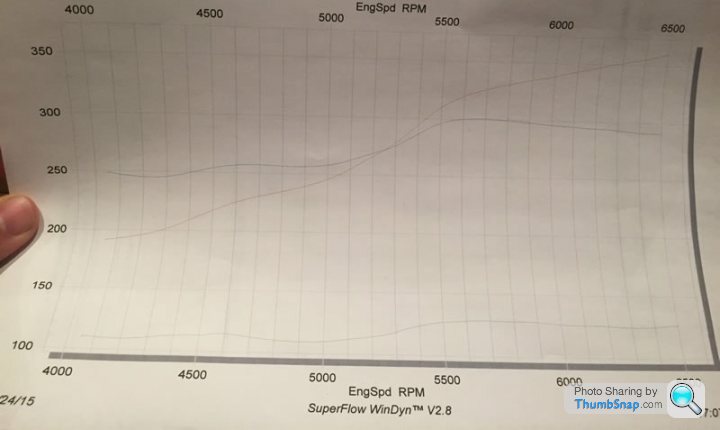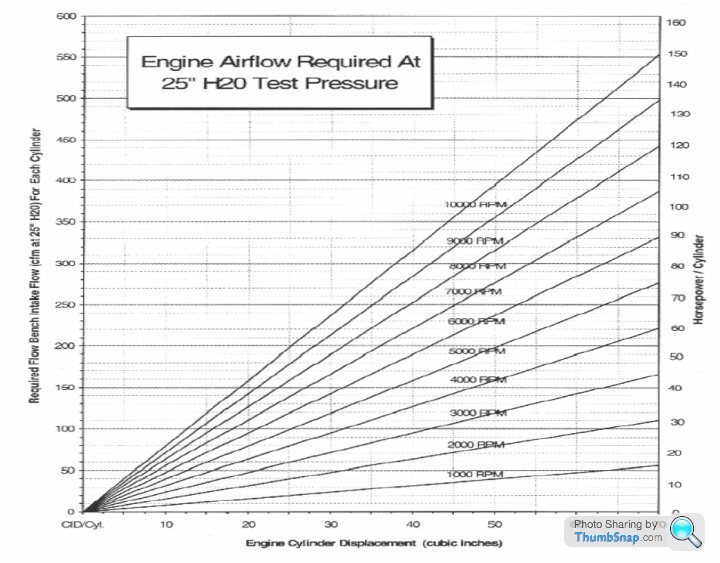Superflow Conundrom
Discussion
Here is an odd one, V8 heads flow tested on a Superflow flowbench. Flow figure according to Superflow operator could only give a max bhp of 330.8. The heads were fitted to a block and run up on the same company's Superflow engine dyno and showed 360 bhp, any thoughts why the difference when both pieces of equipment are Superflow?


Peter


Peter
Interestingly the dyno wasn't taken up to peak power revs for some reason, as can be seen the power is still climbing, the builders reckoned around 7000 rpm peak power and 370+ bhp, designed to be useable to 8000rpm. More power to come with some valve redesign.
The pic attached seems to show 30 cu in engine with the measured flow should give around 344 bhp at 25" flow and 7000 rpm peak.

The pic attached seems to show 30 cu in engine with the measured flow should give around 344 bhp at 25" flow and 7000 rpm peak.

Thinking further about this, the Superflow chart is for full intake/inlet system flow, the flow figures I showed were for port flow alone so one could pretty much assume the flow would be a little less with the full inlet system attached. So it looks like the flow to bhp conversion is even further off in this case. It also makes one think, if someone used the system or system maths to dictate maxima they may well fall short of the bhp that can be achieved?
Peter
Peter
Interesting what you say about +/- on BMEP, personally I have never understood calculated/guesstimated power limitations, just constraints to push forward, lower bhp advances as we get down more to the nitty gritty 
I attach flow figures from a head tested at same time as the other one. This was predicted to make 343.8 bhp, in practice the dyno operator has seen max of 340 bhp from this company's heads. Maybe a lot in what you say about +/- effects from combustion, especially it would seem with the humble old Rover V8 engine. Main differences I could see with the two heads was little or no top cut on the valve seat on the '343.8' heads, all the protruberances surrounding the spark plug had been removed on the '343.8' heads and I had the 'feeling' the valve throats were a little wide/big compared with the expected flow limitations (vol of flow and flow effects) I envisaged with the rectangular ports.

Peter

I attach flow figures from a head tested at same time as the other one. This was predicted to make 343.8 bhp, in practice the dyno operator has seen max of 340 bhp from this company's heads. Maybe a lot in what you say about +/- effects from combustion, especially it would seem with the humble old Rover V8 engine. Main differences I could see with the two heads was little or no top cut on the valve seat on the '343.8' heads, all the protruberances surrounding the spark plug had been removed on the '343.8' heads and I had the 'feeling' the valve throats were a little wide/big compared with the expected flow limitations (vol of flow and flow effects) I envisaged with the rectangular ports.

Peter
An update. Last year the car struggled to fuel correctly. This year the heads now have my own shape inlet valves, larger ports that show a theoretical max of 420 bhp and a set of shiny new Webers. On HT racing rolling road flywheel power last year was 380 (close to the superflow dyno figure?) and this year with the larger ports and nice shaped valves we now have 408 flywheel power and 326 lbs/ft torque. First race was at Rockingham last Sunday, pole position, race win, fastest lap and lap record. Close race though only half a second 1st to 2nd after 10 laps! Looks like the Superflow flow bench prediction was miles off 
Peter

Peter
Hi Eliot, I can remember spending hours and hours with a Vic 16 then 20? till the answer came out the same as 10 mins for each lift on a calculator 
Hoffman900, not my power figures. Last year on HT Racing rolling road identical engine 380 calculated flywheel, they also have Superflow dyno ( not the one from first post which was a different company)and numbers are very similar I am told. Fuelling nothing to do with port sizess and I never said they were. Fuelling problem caused by carburettors and cured with new carbs. Ports were not large enough to go past 400 bhp as they originally were. We worked hard to get em as large as we dare on the inlet side.This year figures now 408 flyhweel calculated. Maybe others Sateside make our stuff look crap but we are pretty pleased with the progress we have made in the last two years starting pretty much from scratch with all aspects of the engine from crank design upwards. We last worked hard on developing the Buick V8 in the early 90s when we dominated the UK TR racing with a TR8. You have to remember the numbers are pretty irrelevant, the race wins, lap records and championships speak for themselves in terms of holistic team effort when compared with the teams who do not win. This must be the same Stateside, it doesn't matter how much folk blow their own trumpet it is for the race track to deliver the obituaries of the front runner also rans. Reading the link you added, it has taken me 32 years, first Championship 1987 to realise I don't know anywhere near as much as I thought about engine tuning and the joys of discovering a little more power here and there do not dull after all this time, I find as I get older and pay off debts I can buy better equipment for machining and tuning and power measurement which also helps push the power levels upwards. I will state again my deepest held 'truism' that it is from the mods that do not work as expected one learns the most about power production and reliability.
What I have found is Stateside B series engines would be very good on a long track somewhere where the high rpm bhp works well BUT on the UK tracks the higher revving, to achieve the power and consequently less grunt Stateside engines get burnt by the lower rpm peak grunty UK spec motors.
Peter

Hoffman900, not my power figures. Last year on HT Racing rolling road identical engine 380 calculated flywheel, they also have Superflow dyno ( not the one from first post which was a different company)and numbers are very similar I am told. Fuelling nothing to do with port sizess and I never said they were. Fuelling problem caused by carburettors and cured with new carbs. Ports were not large enough to go past 400 bhp as they originally were. We worked hard to get em as large as we dare on the inlet side.This year figures now 408 flyhweel calculated. Maybe others Sateside make our stuff look crap but we are pretty pleased with the progress we have made in the last two years starting pretty much from scratch with all aspects of the engine from crank design upwards. We last worked hard on developing the Buick V8 in the early 90s when we dominated the UK TR racing with a TR8. You have to remember the numbers are pretty irrelevant, the race wins, lap records and championships speak for themselves in terms of holistic team effort when compared with the teams who do not win. This must be the same Stateside, it doesn't matter how much folk blow their own trumpet it is for the race track to deliver the obituaries of the front runner also rans. Reading the link you added, it has taken me 32 years, first Championship 1987 to realise I don't know anywhere near as much as I thought about engine tuning and the joys of discovering a little more power here and there do not dull after all this time, I find as I get older and pay off debts I can buy better equipment for machining and tuning and power measurement which also helps push the power levels upwards. I will state again my deepest held 'truism' that it is from the mods that do not work as expected one learns the most about power production and reliability.
What I have found is Stateside B series engines would be very good on a long track somewhere where the high rpm bhp works well BUT on the UK tracks the higher revving, to achieve the power and consequently less grunt Stateside engines get burnt by the lower rpm peak grunty UK spec motors.
Peter
Gassing Station | Engines & Drivetrain | Top of Page | What's New | My Stuff



